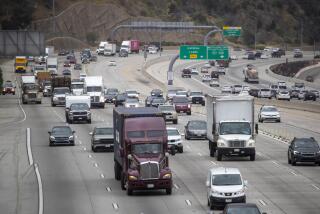Keeping your pets safe in a car
I sat in the back seat of an editor’s car on the way to lunch some time ago and spent the rest of the afternoon smelling like his golden retriever Winnie, not to mention wearing almost a full coat of Winnie’s fur on my black pants.
Cars are designed for people, but increasingly Americans are driving around with their 60 million pet dogs and sometimes with their 70 million pet cats. Many millions of Americans travel each year with their pets, the travel industry says.
Dogs seem to fall into two groups, the ones that jump at the chance of getting into a car and the others that have to be dragged by the leash to the car door. Given the ripeness of Winnie’s scent in the back seat of my friend’s car, I suspect he is a car lover. I have never known a cat that liked being in a car, but more on that later.
By contrast, cars seem to fall into one category: generally pet unfriendly. Along with all the missed opportunities auto and truck makers have made with respect to humans, I can’t fathom how not a single company has come up with original equipment designed for animals: water trays, treat dispensers and deodorizers.
With so much dog activity in cars, it is also inevitable that many are being injured or killed in accidents, but nobody can quantify this. The federal government keeps reliable statistics on human fatalities, but local police agencies generally do not report on killed pets and federal accident reporting forms do not include categories for nonhuman fatalities.
It is widely estimated that 100,000 dogs each year fall from the beds of pickup trucks, though I have never seen an original source for this figure or any kind of research that validates it.
It was only a matter of time before somebody would think of insuring pets involved as passengers in car accidents. The first to claim this invention is the Progressive Group of Insurance Companies, which is now offering a $500 payout if a customer’s dog or cat is hurt or killed in a car accident.
The company says it is one of many service and product innovations it has come up with. The pets are automatically covered and there are no additional premiums for the coverage (or discounts if you don’t have a cat or dog).
I don’t know too much about the vet cost of trauma care for a dog, but I have a hunch that $500 would not fully cover the cost of a major injury to a pet. And in the case of a pet death, I suppose the $500 would help to buy a new pet, but that is a pretty cold way to view the furry creatures that accompany our lives.
But what’s good enough for humans should be good enough for a dog or cat.
Andrea Arden, a pet expert retained by Progressive, says many motorists fail to take proper precautions when their dog or cat rides in a car. All the things that dogs seem to like to do would require irresponsible behavior on the part of you, the owner, including: allowing your dog to sit in your lap, allowing your dog to sit anywhere unrestrained in the car and allowing your dog to fully stick its head out of the window.
A fairly large selection of dog harnesses are sold to restrain dogs in a car. They prevent a dog from moving around while in the car and theoretically prevent a dog from flying through the air in a crash. But they hardly provide the same degree of restraint that a human seat belt does, and I know of no crash testing of an anatomically correct dog dummy.
What’s so bad about letting your dog have some fun with its head in the breeze, much like a motorcycle rider’s? Arden says it is unsafe for the dog’s eyes.
“Dogs can be comfortable with a harness,” Arden said.
An even safer approach is to put your dog in a carrier, strapped to the seat.
Another idea is to give your dog a little bit of chemically induced euphoria. Rescue Remedy, for example, is an over-the-counter product made for dogs to relieve tension. Feliway is made specifically for cats. But don’t let them drive on that stuff; it could prompt a DUI ticket.
Arden explained that cats hate cars because they associate them with going to the vet. So, when a pet is young, an owner should take it fun places, so the car isn’t solely part of the vet experience. But where do cats go besides the vet?
Now, regarding that back seat dog odor. Golden retrievers have what’s called a double coat, meaning they can be really smelly. If they get wet and then crawl into a car, they leave huge amounts of scent on the seats. Arden suggests you can bathe a dog up to once each week to keep it smelling fresh and clean.
If you do ferry around your animals in the back seat, you probably should keep the seats covered with a special car seat cover or a blanket.
Also, you should vacuum your car at least once a week, says Mike Pennington of Meguiar’s, the car care products company. Much of the smell comes from the hair.
You should also wipe down the interior with a specified interior cleaner. And rather than use scents or perfumes inside the car, use a product that gets rid of bad smells, such as Car Odor Eliminator by Meguiar’s, which has a dog on the can.
More to Read
Sign up for Essential California
The most important California stories and recommendations in your inbox every morning.
You may occasionally receive promotional content from the Los Angeles Times.











